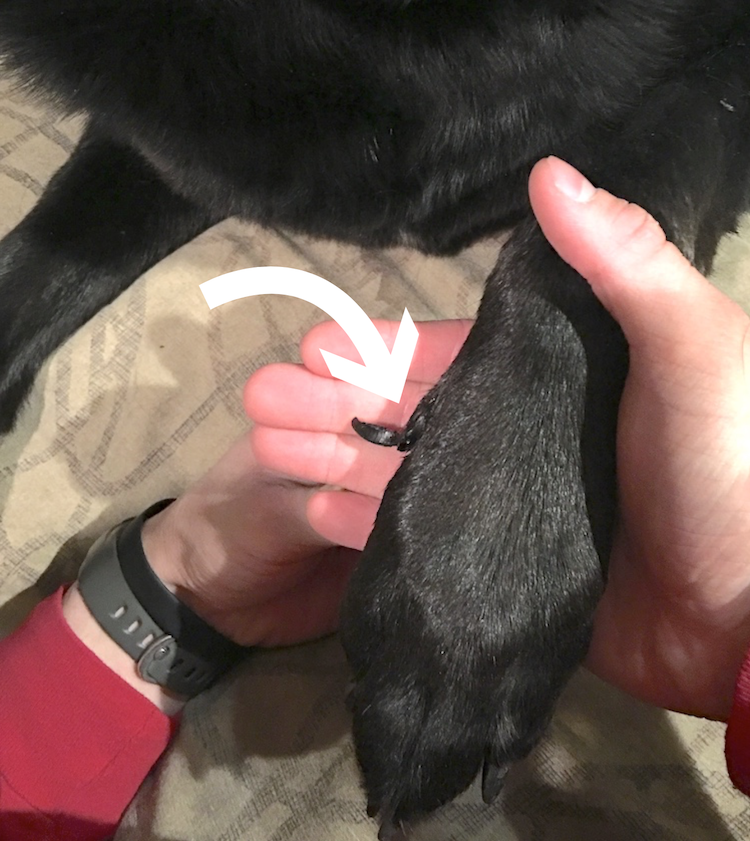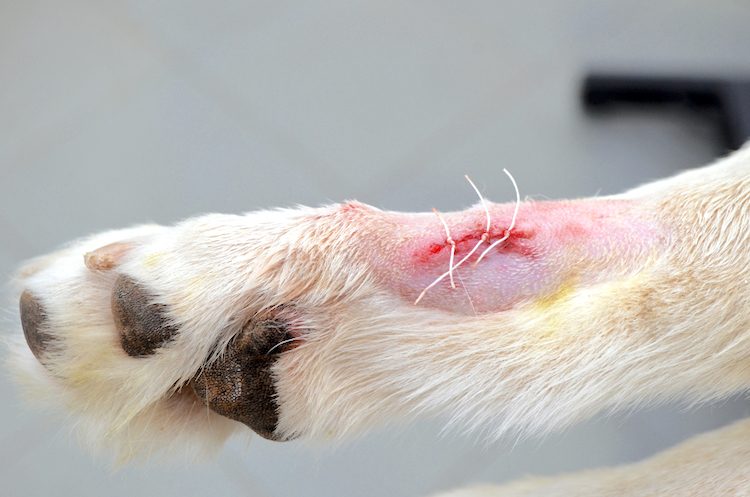
What is a dewclaw? It’s that little digit on your dog (or cat’s) inner front leg, somewhat analogous to our thumb.
Although dewclaws are nowhere near as helpful to a dog as a thumb is to a human, they still have a purpose.
Some people think their dogs’ dewclaws should be removed. But dewclaw removal is necessary only in cases of severe injury or disease.
Why Is It Called a Dewclaw?
Think about grass with drops of dew on top: As a dog prances through the field, the claw higher up on the leg catches the dew on the top of the blades of grass — thus the term “dewclaw.”
Front and Rear Dewclaws
- Front dewclaws: All dogs are born with a dewclaw on each front leg.
- Rear dewclaws: Some dogs are born with 1, 2 or even double dewclaws on the rear legs.
Rear dewclaws are considered an anomaly except in a few breeds where single or double well-developed rear dewclaws are part of the breed, such as the Briard or Great Pyrenees. These should not be removed.

Do Dewclaws Have a Purpose?
Front dewclaws help dogs grasp things using their forelegs, such as a toy, ball or food. Although dogs can hold on to things without a dewclaw, the dewclaw is a helpful addition for grasping.
More important, perhaps, dewclaws most likely help stabilize the carpus (ankle):
- For agility dogs, leaving the dewclaw in place helps them with tight turns and most likely prevents arthritis in the carpal joint as they age.
- The dewclaw actually does touch the ground in racing and coursing breeds when the dog makes tight turns.
- Rear dewclaws in climbing breeds such as the Saint Bernard and Great Pyrenees are thought to help them while climbing rough terrain.
Generally, however, when there is a dangly, floppy rear dewclaw, it serves no purpose. There is probably a benefit to dewclaw removal in these cases since they can get caught and become injured.

Should Dewclaws Be Removed?
There is no valid medical reason for front dewclaw removal and even removal of well-developed rear dewclaws unless there’s a diseased dewclaw or dewclaw injury.
Front dewclaws are a normal part of a dog’s anatomy. They are attached to the carpus by a separate metacarpal bone, forming an actual joint with the carpus.
These front dewclaws have their own nerve and blood supply, muscles and tendons, just like the 4 toes that touch the ground.
It became customary to show certain breeds at dog shows with dewclaws removed, and this is where many people got the idea that dewclaws should be removed. It was also thought that hunting breeds may injure their dewclaws while working, leading to removal.
In the past 10–20 years, however, removing dewclaws has fallen out of favor with many veterinarians, although some breeders still prefer to have the dewclaws removed.
For many vets, it has become an ethical issue:
- Why remove body parts unnecessarily?
- Why remove front dewclaws that most likely do serve a purpose and rarely get injured?
For example, Dr. Emma Goodman Milne, BVSc, MRCVS, has lamented that vets “may feel under pressure to perform procedures they feel uncomfortable with purely because a client says the law allows it.” She said she “will continue to exercise my right not to perform any unnecessary mutilations whether the law allows it or not.”
Although the American Kennel Club (AKC) condones dewclaw removal in certain breeds, just as it does tail docking and ear cropping, the group says no dog will be disqualified without these alterations:
“The American Kennel Club recognizes that ear cropping, tail docking, and dewclaw removal, as described in certain breed standards, are acceptable practices integral to defining and preserving the breed character and/or enhancing good health. Appropriate veterinary care should be provided.
AKC rules do prohibit changes in appearance ‘except as specified in the standard for the breed.’ If a breed standard provides for ear cropping, tail docking, or dewclaw removal, it is permitted. No AKC breed standard has a disqualification for any of these alterations.”

Front Dewclaw Removal
If dewclaw removal is to take place, this procedure should be done by the time the puppy is 3 days old.
Although it’s a simple procedure — over in less than 1 minute — neonatal puppies feel pain, and dewclaw removal in a neonate is done without general anesthesia.
Was YOUR Pet Food Recalled?
Check Now: Blue Buffalo • Science Diet • Purina • Wellness • 4health • Canine Carry Outs • Friskies • Taste of the Wild • See 200+ more brands…

For those vets who still agree to remove dewclaws, many use a local lidocaine injection to block pain. Nevertheless, the lidocaine injection hurts, the puppies still cry and feel some pain.
Complications, such as infection or regrowth of the nail, are possible.
Some breeders perform dewclaw removal themselves. Vets usually charge a puppy exam fee and a dewclaw removal fee for each puppy. Depending on the practice, this cost is around $30–$40 per puppy and up.
People sometimes ask, “Can you remove dewclaws on an older dog?” Dewclaw removal done at a later age is a surgical procedure requiring general anesthesia.
Although there’s no medical reason to remove normal front dewclaws on older puppies or dogs, some vets still agree to do this unnecessary surgery. If done at the same time as a spay or neuter, the dog undergoes only a single general anesthesia.
Rear Dewclaw Removal
If a dog is born with floppy rear dewclaws, these floppy dewclaws can get ripped or injured more easily than well-developed ones.
Floppy dewclaws don’t usually have much bony attachment to the tarsus (ankle), so the dewclaw removal is fairly easy.
Most puppies aren’t brought to a vet when they’re 3 days old, so most puppies with rear dewclaws are older when the question of removing the dewclaws comes up. If the puppy is brought in to be spayed or neutered, rear dewclaw removal can take place at that time.
Bear in mind, however, that there is an additional charge for the dewclaw removal, and the puppy may have bandages on the rear legs for 7–10 days, as well as an Elizabethan collar.
Recovery from dewclaw removal in an older dog can cause dogs and people more headaches than recovery from the spay or neuter. It’s not uncommon for dogs to chew at their bandages and dewclaw incisions, remove the sutures entirely, or get the incisions infected.
I’ve had to re-bandage many dewclaw removal sites for an extra 1–2 weeks, treat the dog with antibiotics at times, or actually anesthetize the dog again and re-suture if the dog has self-traumatized the area.
The dewclaw removal cost varies greatly from vet to vet and pup to pup:
- The surgical fee will be minimal if there’s only a small skin incision to remove a dangly little nail, or it will be more expensive if the dewclaw has a joint and must be disarticulated from the leg.
- Vets will charge a surgical fee and may add a charge for local anesthesia, additional general anesthesia and a bandaging fee.
- If there are complications with healing, of course there’s a cost for that, too.
Listen to this veterinarian speak about dogs’ dewclaws and some potential risks in dewclaw removal:

Dewclaw Maintenance
Front dewclaws rarely touch the ground and are usually a bit longer than the other 4 toes.
They require trimming every few weeks to every few months. Dogs generally don’t mind a quick trim of these dewclaws as much as they mind you trimming their regular nails.
Rear dewclaws seem to cause more problems. The conformation as well as the actual nail can be abnormal, leading to a nail that may grow more quickly or is actually closer to the pad, making it difficult to trim.
People also simply tend to forget about rear dewclaws.
If a dog is continually coming to see me for problems with abnormal, hard-to-maintain dewclaws, I discuss dewclaw removal with the client.
Injured Dewclaws or Diseased Dewclaws
Ripped or injured toenails and digits are common in dogs.
You might be surprised that injuries are more common in the toes that touch the ground than in normal dewclaws.
Ingrown dewclaws can be painful and lead to infection, generally requiring a vet visit.
I trim back the nail, treat the wound, and dispense pain meds and antibiotics if necessary until the area where the nail grew into the pad or skin is healed. (This is a fairly common problem in some older cats as well.)
Nail bed infections or growths can occur that affect the dewclaw.
The treatment for an injured, diseased or ingrown dewclaw varies greatly from patient to patient. If treatment of a dewclaw requires general anesthesia or if the dog has presented multiple times for the same problem with a dewclaw, then dewclaw removal might be the humane choice.

At a Glance: When Is Dewclaw Removal Necessary?
| Scenario | Dewclaw Removal Necessary? |
|---|---|
| Dog has well-developed front dewclaws. | No. Front dewclaws are normal in dogs. Trim them just as you would other dog nails. |
| Dog has 1 or more well-developed rear declaws, but these are not usual for the breed. | No. Dewclaw removal is not necessary unless there’s a medical problem. |
| Dog has a ripped, injured or ingrown dewclaw. | Probably not. See your vet for treatment. |
| Dog has a declaw that is severely injured or keeps getting injured. | Maybe. See your vet for treatment. |
| Dog has a declaw that is infected or diseased. | Maybe. See your vet for treatment. |
| Dog has rear declaws that are abnormal and hard to maintain. | Maybe. Consult your vet. |
| Dog has a dangly, floppy rear dewclaw. | No … but possibly helpful. Removal of floppy rear declaws may prevent future injury. Consult your vet. |

Final Thoughts on Dewclaw Removal
- Front dewclaws are normal in dogs.
- Dewclaw removal is not called for unless there’s a medical problem.
- Get your dog used to having their dewclaws trimmed.
- Keep an eye on all of your dog’s nails — but pay particular attention to dewclaws, both front and rear.
- Seek treatment for any injured nail.
Wishing you happy nails on happy trails!
References
- Coren, Stanley, PhD, DSc, FRSC. “Why Do Dogs Have Dewclaws?” Psychology Today. Oct. 15, 2014. https://www.psychologytoday.com/us/blog/canine-corner/201410/why-do-dogs-have-dewclaws.
- “Conformation: Frequently Asked Questions.” American Kennel Club. https://www.akc.org/sports/conformation/resources/faq/.
- Evans, Howard E., PhD, and Alexander de Lahunta, DVM, PhD. Miller’s Anatomy of the Dog, 4th edition. Elsevier Health Sciences, 2013.
- Bojrab, M. Joseph, DVM, PhD. Current Techniques in Small Animal Surgery. Lippincott, 2014.
- Milne, Emma Goodman, BVSc, MRCVS. “Removal of the Dewclaws of Dogs.” Veterinary Record 162 (June 28, 2008): 868. https://veterinaryrecord.bmj.com/content/162/26/868.2.
- “Why Is the RSPCA Opposed to the Tail Docking of Dogs?” RSPCA. Aug. 23, 2014. Archived at https://web.archive.org/web/20180414145556/http://kb.rspca.org.au/Why-is-the-RSPCA-opposed-to-the-tail-docking-of-dogs_135.html.
 This pet health content was written by a veterinarian, Dr. Debora Lichtenberg, VMD. It was last reviewed Jan. 8, 2019.
This pet health content was written by a veterinarian, Dr. Debora Lichtenberg, VMD. It was last reviewed Jan. 8, 2019. 

